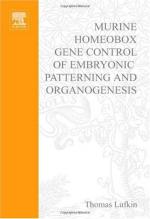|
This section contains 824 words (approx. 3 pages at 300 words per page) |

|
Morphology, i.e., the shape of body structures and organs, are determined by a class of genes known in mammals as Hox genes (that is homologous to Homeotic genes in Drosophila melanogaster, or fruit fly). Hox genes are also termed selector genes or morphogens because they are responsible for cells' shape and for the tissue-specific specialized functions of cells, known as cell differentiation.
Although animal morphology varies among species, molecular biology has discovered in recent years that Hox genes are present in every animal species. Hox genes all contain a highly conserved nucleotide sequence called homeobox. Homeobox is a short stretch of about 180 nucleotides whose base sequence is very similar in all Hox genes (and Drosophila's homeotic genes). Apparently, homeoboxes regulate both timing and location of expression of particular groups of genes along a given embryonic axis during development.
A highly conserved structure or feature implies...
|
This section contains 824 words (approx. 3 pages at 300 words per page) |

|


